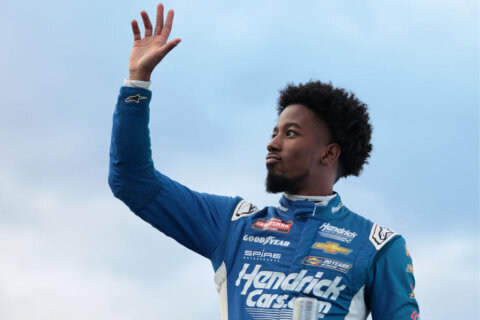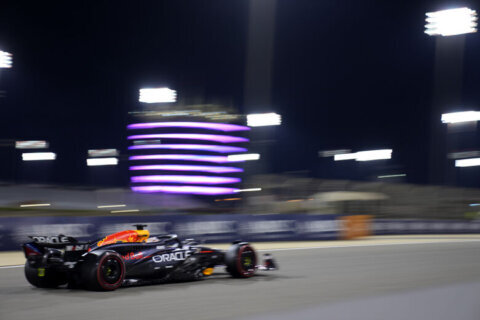ATLANTA (AP) — There are sports heroes who roll off the tongue.
Michael Jordan. Babe Ruth. Tiger Woods. Tom Brady.
Then there are those who aren’t quite as obvious, despite their enormous impact.
Tucked underneath a towering highway overpass in northeast Atlanta is a nondescript brick warehouse.
That’s where you’ll find Jim Downing, the man who helped save auto racing.
A long-time sports car racer, he got tired of so many of his friends and competitors dying at the track. For that matter, Downing had been spooked by his own violent wreck at the Canada’s Mosport road course in 1979.
“I was lucky,” Downing conceded.
So, he studied up on the issue, much like you’d expect from his bespectacled, professor-like appearance. Many of the deaths, he found, were caused by basilar skull fractures — essentially the head snapping forward violently in a high-impact wreck, while the rest of the body was tethered to the seat by belts and harnesses.
In a fortunate twist of fate, Downing’s brother-in-law, Bob Hubbard, taught biomechanical engineering at Michigan State University, worked with General Motors and also had a keen interest in racing.
Downing took his ideas to Hubbard, who came up with a simple, U-shaped contraption that goes around the neck and tethers to the helmet, keeping the head stable in high-speed crashes.
The Head And Neck Support device, they called it.
HANS, for short.
Since its widespread introduction two decades ago, sparked by the stunning death of seven-time NASCAR champion Dale Earnhardt on the final lap of the 2001 Daytona 500, the HANS has become a standard piece of safety equipment in pretty much all forms of racing.
“I feel like it changed racing across the world,” says Chase Elliott, the reigning NASCAR Cup champion.
Indeed, the HANS was at the forefront of a remarkable era of improved safety in all forms of racing, along with softer walls, more protective seats and halo-like devices that guard open-cockpit drivers from flying projectiles.
Earnhardt was the last driver in any of NASCAR’s top series to die in a crash. Formula One has lost only one driver in the last 27 years (Jules Bianchi, in a freak accident when his car slid off a rain-soaked track and slammed into a tractor that was collecting another wrecked machine). Four IndyCar drivers have died in the last two decades, but the toll surely would have been higher without the HANS and other safety improvements.
At age 79, Downing still races occasionally and spends the rest of his time tinkering on an impressive collection of high-powered machines at a shop that doubles as a de facto museum, displaying everything from a futuristic, 1950s Lotus to the original sign that stood outside Road Atlanta after its opening in 1970.
“I usually work six days a week,” Downing said, stepping out from the workshop that remains a cacophony of drilling and sanding and welding. “We’re busier than we’ve ever been.”
But anytime he watches a race, Downing still finds himself taking note of crashes that would’ve been much worse without the HANS.
“We all say, ‘Ohhh, that’s a HANS accident,’” he said. “If someone hits totally sideways, the HANS doesn’t really apply much. But anything that’s forward to 30 to 40 degrees left or right is a HANS accident. So we pay attention to those.”
So do many others. Before Downing and Hubbard figured out a way to reduce the body count, auto racing’s very existence was being questioned
In NASCAR alone, four drivers in the top three series were killed in a gruesome nine-month stretch covering 2000 and early 2001, culminating with the death of the sport’s biggest star in its biggest race.
Earnhardt and the others — Adam Petty, Kenny Irwin Jr, and Tony Roper — all died from basilar skull fractures.
In an especially tragic twist, Downing and Hubbard had developed a workable HANS by the mid-1980s, but they were so far ahead of their time that most racers scoffed at the mere suggestion of wearing such a strange-looking device.
“Nobody was interested,” Downing says with a chuckle, putting a present-day spin on what he was up against. “I heard every argument in the world why ‘I don’t want to wear one.’ It’s almost like vaccines. There’s so much illogic out in the world that it astounds you.”
The resistance began to soften after Formula One’s biggest star, Ayrton Senna, and another driver, Roland Ratzenberger, were both killed on the same weekend at the 1994 San Marino Grand Prix.
Indy Car got interested after budding star Gonzalo Rodriguez died from a basilar skull fracture when he slammed into a wall at Laguna Seca in 1999. Michael Andretti helped with much of the testing.
But there was hardly a rush to embrace the device — especially in NASCAR, the most popular racing series in the United States.
“We started offering them for sale in 1991. For the next 10 years, we sold 250, which is to say we lost money on every single one,” Downing said. “But we believed in it.”
Then Earnhardt was killed.
And everything changed.
“That, suddenly, put us in business,” Downing said. “The next week, I took orders for 250. And I had three on the shelf.”
Downing ramped up production at his racing and composite facility, the building he still occupies today. He hired extra workers and hastily cleared out space in the back to set up an assembly line to make the HANS, but demand far outweighed production for a while.
“I had people mad at me for a year because we couldn’t supply them fast enough,” Downing said.
There was still a smattering of resistance from drivers who thought the HANS was bulky, uncomfortable and limited their field of vision. NASCAR held out for several months after Earnhardt’s death before the HANS finally became mandatory.
Kevin Harvick, who took over Earnhardt’s car after his death, was also reluctant to wear the HANS. He initially went with another approved head-and-neck system, the Hutchens, because he found it less restrictive.
“At that particular time, none of us wanted to use any of it,” Harvick recalled. “They were forcing us to change, thank God.”
The Hutchens device was eventually banned by NASCAR, which said it didn’t provide the same level of safety as the HANS.
Now, no one has a second thought about strapping that U-shaped device around their neck.
“I don’t know that I would ever get in car without one,” Elliott said. “That’s an absolute must-have.”
Downing eventually bought out Hubbard, then sold off rights to the HANS in 2012 to motorsports parts giant Simpson, which was much better positioned to produce the device in large numbers.
Hubbard died a couple of years ago, and the patent to their groundbreaking device has since expired, though Downing still maintains a local HANS dealership that sells to Atlanta-area racers.
He shrugs off any attempt to shower him with praise for the countless lives saved by his co-creation.
“It’s just progress through the years,” he said nonchalantly.
No, it’s much more than that.
Jim Downing is a true sports hero.
Right up there with those names we know so well.
___
Paul Newberry is a sports columnist for The Associated Press. Write to him at pnewberry(at)ap.org or at https://twitter.com/pnewberry1963 and check out his work at https://apnews.com/search/paulnewberry
___
More AP auto racing: https://apnews.com/apf-AutoRacing and https://twitter.com/AP_Sports
Copyright © 2024 The Associated Press. All rights reserved. This material may not be published, broadcast, written or redistributed.







